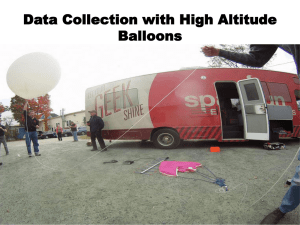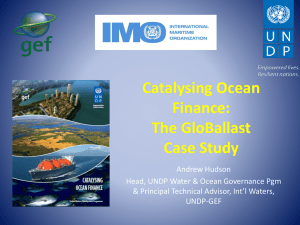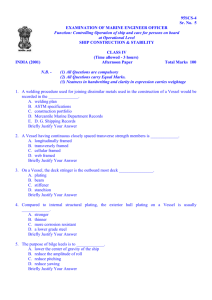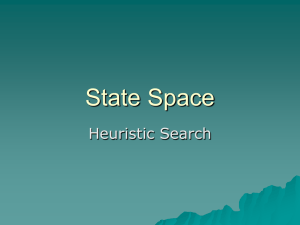1.2 MB doc - State University System of Florida
advertisement
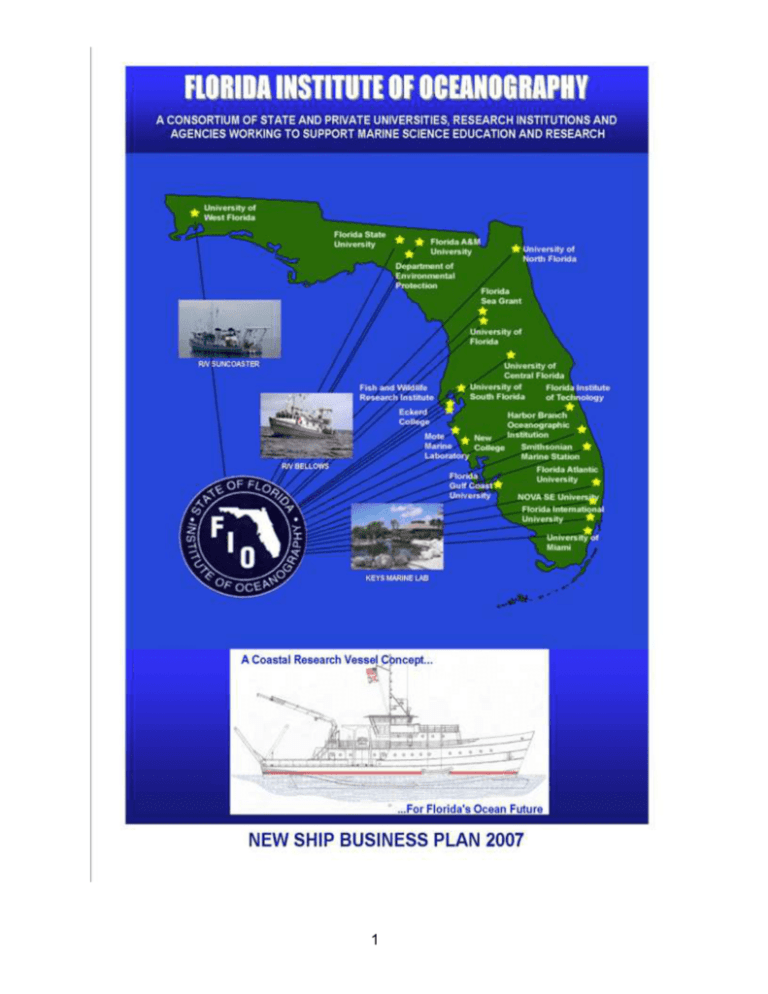
1 2 FLORIDA INSTITUTE OF OCEANOGRAPHY NEW RESEARCH VESSEL Business Concept The Florida Institute of Oceanography (FIO) was established to provide an affordable infrastructure necessary to support Florida’s coastal marine science and oceanography programs in education, training, research, public outreach, and marine resource management. For 35 years the state has realized this goal through the centralization of FIO facilities and services including research vessels, laboratories, technical support, and multi-institutional grant/contract management on behalf of Florida’s public and private ocean science education and research community. The FIO provides the expensive capital facilities for ocean training and research that no one member can readily afford or justify individually, but which are critical to the State’s institutions and agencies. Collectively the 21 member FIO consortium (see cover map) is one of the largest coalitions of oceanographic education and research organizations in the country. No other organization in the State supports, attempts to support, or is able to support the broad diversity of needs, goals, programs, and missions of the statewide FIO consortium. The facilities and services of the FIO are specifically targeted to Florida’s coastal ocean issues and the missions and goals of its members. This captures a broad and sustainable market niche locally and regionally while allowing access to more national/international oriented market opportunities. FIO facilities currently include: Research Vessel BELLOWS 71’ Research Vessel SUNCOASTER 102’ Keys Marine Laboratory – nine buildings on eight acres Current Facility Operations Over the last five years the Institute has generated more than $15 million in outside grants and contracts, 92 percent of which have been directly distributed to member research and education programs. State researchers have estimated that 30-70 percent of their successful programs have resulted from FIO support. Collectively the state’s public universities alone generate an estimated $75-85 million per year in marine science and oceanographic research grants and contracts. Many related programs, particularly in the health sciences, marine bioproducts, pharmaceuticals, marine sensor technology, and aquaculture, increase that total significantly. 3 FIO ship support for these programs generates the $800-900,000 user-based cash flow currently necessary for the operation of the state's primary research fleet. It is important to note that these funds are spent almost entirely within the state and, based on standard economic multipliers, can be contributing financial engines in some local economies. Based on actual ship days awarded and contracted for the state fiscal years 01/02 through 05/06, Chart I shows the distribution of FIO ship use by all university, state, and federal agencies including FIO/state funded use awarded to the consortium membership. The distribution illustrated is consistent with the pattern of the last ten years. This reflects the broad based dependence of the 21 member constituency on the state’s FIO resources to accomplish institutional and agency missions. While the chart shows the domination of state university users and illustrates why the operation of the FIO is housed within the State University System, it also clearly shows that no single member or organization has the resources or use level sufficient to support the facilities independently. All users of shiptime are charged per diem costs at audited and approved, predetermined, fixed daily rates. Rates are based on a 24-hour operations day and are allinclusive. One ship day is the basic unit of charge. Daily charges are not prorated or adjusted for number of passengers or transit vs. station time. Collectively the consortium can, and has, sustained these ship facilities and operations for three decades based on this model. Other Agencies (EPA, NASA, ONR, NOAA, FDEP and FWC/FMRI) These agencies use FIO ships through FIO member institutions. The conditions and programs noted above have increased the number and types of grants requiring ship support. FIO ship use is shown by agency/institution on Chart I. With the exception of FWC/FWRI, FDEP and NOAA, the non-university organizations do not generally use the ships for internal agency work. FWC/FWRI, a founding member of FIO, has always been a significant user of shiptime for agency programs, which it funds through cooperative grants and contracts with the FIO. There are additional opportunities to expand business extensively in the Caribbean with an appropriate vessel. NOAA maintains a cooperative agreement with FIO allowing the consolidation of funding to FIO member institutions and programs through the Institute's management services. Any office of NOAA can use the agreement to transfer funds to FIO for distribution to FIO members or for use directly by NOAA. To date, the Man in the Biosphere Program and the National Marine Fisheries Service have used the state ships for agency purposes. Of shiptime funded by NOAA under the agreement, 88 percent has been in direct support of FIO member institutions. 4 Chart 1 Customer Base University, State and Federal Agency Ship Use Based on 5 years (1,317 fleet days) FY 01/02 - FY 05/6 DEP 3% NOAA 4% Private 1% EPA 5% USF 23% ONR 4% U.S. DOS 2% USGS 1% FWRI 4% FGCU 2% MOTE 4% FIU 4% NOVA 3% MIAMI 2% FAU 9% ECKERD 1% UCF 4% FSU 4% UWF 9% FAMU 3% UF 7% FWRI- Fish and Wildlife Research Institute USGS-U.S. Geological Survey U.S. DOS-U.S. Department of State ONR-Office of Naval Research EPA-Environmental Protection Agency NOAA-National Oceanic and Atmospheric Adm. DEP-Department of Environmental Protection Private Users 5 Market Analysis Current Market The state universities are the primary clients and beneficiaries of the research vessels. FIO awards grants to consortium members averaging 125-140 days of shiptime per year. These grants are funded centrally through the FIO state budget. Awards are based on competitive proposals submitted by university faculty. These grants are equal to $500-570,000 of direct and indirect funding for education and research programs at Florida’s education and research institutions. Growth and expansion of marine programs, environmental science and policy degree programs, and marine science graduate programs have increased university demand and dependence to a 30-year high. Proposals for shiptime in 2006-07 exceeded 200 on-station days, which with transit days, would require a 280-290 day operating schedule. Current state funding to FIO cannot support that level of internally awarded activity, but it is clear evidence of increasing demand and is consistent with the trend observed since FY 94/95. In addition to the growth and nationally recognized quality of Florida’s ocean science curricula and faculty, Florida's unprecedented environmental restoration and monitoring initiatives and growing academic/high technology industry partnerships have focused significant attention on ocean issues and fueled demand for multidisciplinary coastal ocean studies and the sea-going research infrastructure to support them. Market Target and Opportunities Regionally and locally based research platforms specific to the demands of modern coastal ocean studies are not readily available or affordable, which makes the state's fleet the vessels of choice in the region and creates a growing potential market for the FIO ships. Major research programs in the Gulf of Mexico/ Caribbean region are underway or under development. The Integrated Ocean Observing System (IOOS) is already partially established in Florida and requires regular ship support from FIO. This coastal ocean monitoring system is poised to expand significantly and will require more shiptime and more ship technology. Other programs like EcoHab (Ecology of Harmful Algal Blooms) and the increasing demand for expanded Red Tide research on Florida’s coasts will also require extensive ship support as will the newly created Gulf of Mexico/Florida Ocean Initiative. Recognizing the need for the state to take a proactive leadership role in managing our coastal oceans, the Governor and Legislature established the Florida Oceans and Coastal Resources Council to define specific goals and priorities for conserving our coastal oceans while generating economic benefits from their use. This new focus on coastal ocean resources will result in additional demands for ship support. It is important that the state have the proper equipment to fulfill those goals over the next decades. A 21st century research vessel is critical to that role. 6 Product/Services Evaluation Suncoaster costs and condition The Suncoaster is a 40-year-old "drug boat" that was acquired and renovated by the FIO in 1980. It has been the primary ocean platform for grant and contract research programs involving member institutions. The vessel has become increasingly marginal in this supporting role because of its hull limitations, original construction, lack of scientific storage space, lack of adequate isolated laboratory spaces and under way data acquisition capability, and limited number of accommodations for scientists. Modern coastal ocean science demands expanded multidisciplinary capabilities and technologies to address critical marine issues. In more and more cases the Suncoaster cannot meet, nor can it be modified to accommodate, the expanding scientific demands. In spite of increased business and revenues, maintenance and repair costs for the Suncoaster consume more of the budget than ever before. An ever-increasing portion of the operations funding must be expended on repairs and escalating maintenance. The age and condition of the ship preclude economically feasible modifications. This severely limits any upgrades that might be considered and critically restricts improvements to those life and safety issues mandated by law. The vessel is old, overworked and obsolete. Graph I tracks Suncoaster costs vs. revenues over the last nine years. The graph shows a predictable trend associated with aging, obsolete capital facilities. Aside from an increasing inability to serve complex research missions, the Suncoaster's mechanical and structural components need increasingly expensive, intensive maintenance, overhaul, and repair which pre-empt significant technical or capability enhancements. These costs are driving the Suncoaster ship rate to unmarketable levels while providing no improvement or expansion of service or capabilities. Current increases in activity and ship rate can barely keep pace. These escalating costs and structural limitations will ultimately result in non-competitive marketability, significant loss of business and an operational dependence on internal, state-funded resources. This predictable vulnerability was highlighted by the 2004-2005 hurricane seasons which disrupted schedules resulting in multiple contract shiptime cancellations and severely impacted cash flow revenues. In the same timeframe serious structural failures in the hull required major repairs. The repairs were only accomplished by depleting all reserve funds and acquiring a bridge loan from the university system. Such future events could easily create a condition in which the continued operation of the Suncoaster would be unsustainable. This would effectively remove the Suncoaster from state service and leave Florida's academic and environmental agencies dependent on distant, mostly out-of-state operators at considerably greater expense. 7 Graph I RV SUNCOASTER FISCAL OPERATIONS FY 94/95 - FY 05/06 $800,000 Maximum attainable operation Maximum attainable operation Post hurricane schedule recovery $700,000 $600,000 Increase in demand $500,000 $400,000 Deferred maintenance Multiple hurricanes (Weather cancellations) $300,000 Major maintenance $200,000 Major repair Fiscal Year Revenue 94/95 95/96 96/97 97/98 98/99 99/00 00/01 01/02 02/03 03/04 04/05 05/06 $310,389 $357,571 $309,584 $433,057 $523,809 $617,700 $673,434 $746,028 $715,265 $565,938 $639,893 $582,699 Costs $277,950 $357,534 $360,602 $389,749 $506,640 $605,150 $553,320 $717,084 $685,451 $546,580 $554,598 $599,694 Major maintenance: Regularly scheduled and planned major overhaul Major repair: Unanticipated capital repairs resulting from age and original construction defects 8 Marketing and Operations Cost Comparison FY 2005/06 Table I shows a breakdown of operational costs for the Suncoaster in FY 05/06. By comparison, a similar breakdown of costs for the proposed replacement vessel is provided based on the same operational schedule for the same time period. The new vessel costs are estimated on the basis of professional naval architect projections and design specifications, performance criteria, conservative estimates of fuel consumption and costs, and definable increases in personnel costs for technology support and crewing. The significant reduction in maintenance and repair costs coupled with greater design and automation efficiencies create a fiscal and market advantage in operating a new ship. The primary marketability efficiences identified for the new vessel operations are: New automation technologies reducing manning requirements and life cycle costs. Advanced propulsion systems coupled with special hull design allowing recognized fuel savings. Enhanced cruising speeds based on appropriate hull design reducing transit times and maximizing on station science time. Environmentally friendly propulsion system (both in terms of marine life and water quality impact). Advanced electronics and navigation systems allowing vessel tracking within +/- 5 meters, further saving time and fuel. Dynamic positioning capability allowing more efficient science operation and reducing station time. Larger scientific payload, allowing multidisciplinary operations or larger training options in a given discipline. Dramatic improvement in operability and maintainability of vessel systems and equipment with particular emphasis on command, control and safety items. Enhanced livability (a significant marketing factor). 9 TABLE 1 Annual Operational Cost Comparison Suncoaster Costs Estimated New Ship Costs Salaries (5 crew) $ 314,842 (7 crew) $ 435,500 Fuel (@ 1.90 per gal.) $ 73,108 (@2.39 per gal.) $ 119,550 Food $ 26,276 $ Repairs/Maintenance $ 156,078 $ 100,000 Communications/Navigation $ 2,568 $ 3,500 Travel $ 750 $ 1,000 Insurance $ 12,493 $ 20,000 Science/Technical Support $ 370 $ 10,000 6% Admin. Ovh'd $ 13,209 $ 43,623 Depreciation 37,500 0 $ 360,000 Total Costs $ 599,694 $1,130,673 Annual Revenue Comparison Total station days operated Daily charge rate 176 3,300 Total revenue (days x rate) 582,699 Estimated profit/loss Total station days operated Daily charge and depreciation rate 180 6,500 Total revenue (days x rate) $ (16,995) 10 1,170,000 Estimated profit/loss $ 39,327 Depreciation reserve $ 360,000 Vessel Comparison Modern oceanography requires many teams of researchers and technologies impossible to accommodate aboard a vessel like the Suncoaster. The new ship will not be much longer than the current Suncoaster, but it will have a considerably greater volume. Multiple teams of scientists create a critical need for laboratory spaces that can be isolated from other activities, electronics and communications systems for data transmittal, and the ability to conduct multidisciplinary sampling concurrently. The new ship must also have dedicated space for transmission of live telecommunications direct to base stations for rebroadcast to classrooms and research centers. This capability alone would vastly increase the utility of the science programs and expand classroom training options. Length Beam Draft Bow Thruster Satellite communications, Navigation and integrated Data system Lab, main Lab, chem Lab, wet Lab, electronic Study area Science storage below Science storage main deck Freezer/refrigerator Main deck work area Main deck length Total main deck area Fume hoods Van capability, main deck Van, 01 deck Fuel capacity Water capacity Endurance Crew Scientists Tonnage, net Suncoaster New Ship 102' 24' 8' None 125' 32' 8' 200 hp None 350 sf None 50 sf None None None None 125 cf 600 sf 27' port and stb 1,000 sf None One 8 x 20 None 17,500 gals. 8,500 gals. 15 days 5 12 149 Full Capability 400 sf 130 sf 150 sf 60 sf 120 sf 850 cf 800 cf 400 cf 1,030 sf 33' port and stb 3,940 sf 2 Two 8 x 20 One 8 x 20 30,000 gals. 15,000 gals. 30 days 7 18 299 11 Proposed Budget: New Research Vessel, $ 15,000,000 Replacement of the RV Suncoaster is important to sustain Florida's ocean science training and research programs and continue academic and agency leadership in coastal ocean management practices and research. A new vessel, designed for Florida's specific needs, will provide a badly needed platform to support the technologies and interdisciplinary strategies of modern oceanography at a competitive rate with greatly expanded capabilities and marketability. This will enhance operational funding support from national and international sources. The new vessel will be a key support component of Florida's Ocean Initiative, ocean resources research, training and management programs. These programs are critical to an ocean-dependent state economy powered by more than $105 billion in ocean industries and commerce. Design, construction, equipping, and launching the new vessel is budgeted at $14.74 million, a one-time cost. This can all be accomplished in Florida with Florida enterprises. It is important to note that the essential officers and crew along with the organizational infrastructure for ship operations already exists and is funded by the state through FIO. The FIO also operates through, and with the support of the University of South Florida administration and financial services and functions in accordance with university policies and procedures. No additional administrative infrstucture is required. An additional $260,000 in salaries and benefits will be required to complete crewing and technical support (4 FTE positions) for this new vessel. This increase in the FIO budget would be an ongoing cost to the State along with the existing crew salaries. However, these costs will be built into the daily ship rate and are partially recoverable through user fees. No additional funds beyond the existing FIO budget (with the additional crewing supplement) will be required for the operation of the vessel. BUDGET Architect Plan and Design 1.5 M Vessel Construction 9.7 M Outfitting 1.80 M Electronics .47 M Computer Network .40 M Science Systems .87 M Construction Subtotal 14.74 M Crewing (4FTE) .260 M Grand Total 15.00 M 12 PHASED BUDGET Architect Plan and Design 1.50 M Vessel Construction 9.70 M Outfitting 1.80 M Electronics 0.47 M Computer Network 0.40 M Science Systems 0.87 M Construction Subtotal 14.74 M Crewing (4FTE) 0.260 M Grand Total Phase 1 $1.50M Design, engineer, and pre-construction Duration 6-8 months *Phase 2 $11.5M Construction Duration 10-15 months *Phase 3 $1.74M Furnishing Duration 2 months *Note: Phase 3 is included in the last 2 months of Phase 2 15.000 M TIMELINE Phase 1 Month 0-8 Phase 2 Phase 3 Month 8-23 Month 23-24 13
